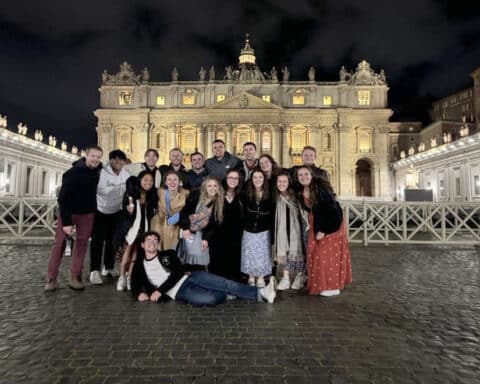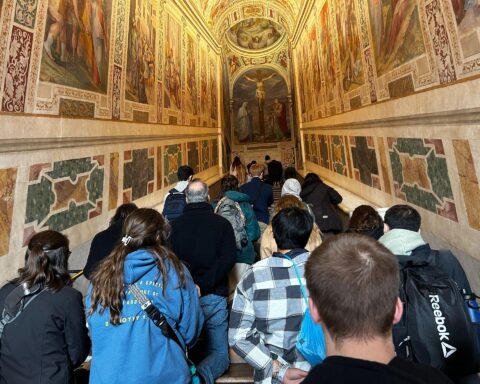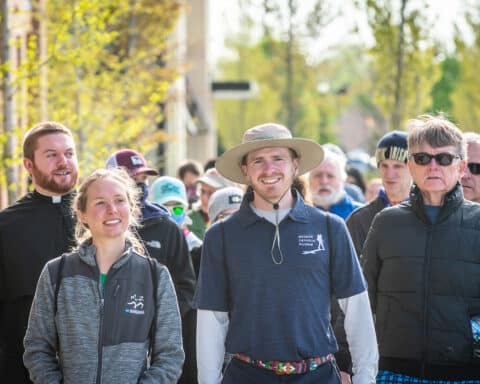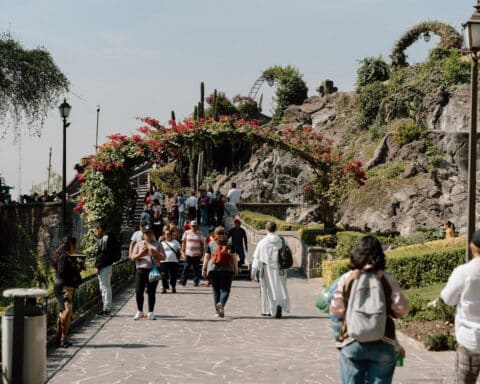Two thousand Catholics, most of Polish ancestry, will walk from Sts. Peter and Paul Church in Great Meadows, New Jersey, to the Shrine of Our Lady of Czestochowa in Doylestown, Pennsylvania, as part of the 32nd annual Walking Pilgrimage on Aug. 8-11. Organizers describe the event as a retreat, providing participants time for “prayer, kindness, brotherly love, singing, self-discipline, confession, Mass” and an opportunity for “listening to speakers and having spiritual conferences.”
The pilgrimage will be led by walkers carrying a cross and Marian images, and it will be divided into three groups: two Polish-speaking, led by Salvatorian priests of Great Meadows and Pauline priests of Doylestown, and one English-speaking, led by New York’s Franciscan Friars of the Renewal. The pilgrimage route spans 57.5 miles and has its participants camping out three nights, twice at public parks and a third time at a family farm in Doylestown.
“The pilgrimage helps our participants to spiritually recharge,” said Eileen Wyss, a staff member of Sts. Peter and Paul Church who oversees the event. Mass is celebrated daily at each stop, she said, and priests follow the walkers and are available for confession and spiritual counseling as they walk.
Began in 1988
The event began in 1988, when the late pastor of Sts. Peter and Paul, Father Ignatius Kuziemski (1935-2006) joined with a dozen friends, including Little Servant Sisters of the Immaculate Conception and young parishioners, for the first walk. Such pilgrimages are common in his native Poland and were encouraged by the pope at the time, Pope St. John Paul II, and Father Kuziemski wanted to popularize the practice in the United States. It quickly caught on, drawing more than 1,900 last year. Although centered in New Jersey’s Diocese of Metuchen, participants come from all over the country, including from as far away as California, Texas and Florida.
The pilgrimage begins at 7 a.m. on a Thursday morning at Sts. Peter and Paul and concludes Sunday afternoon at the shrine. Participants pray, sing or listen to spiritual talks on a public address system along the way; Mass is celebrated in tents in the evening at the overnight stops. The pilgrimage occurs in conjunction with the Aug. 15 feast of the Assumption, with the last day of the pilgrimage occurring within a week of the feast day (or on the feast day, if it is celebrated on a Sunday). Past participants have included Archbishop Thomas Wenski of Miami, who is of Polish ancestry, as well as bishops from Poland. The archbishop is expected to return again for the pilgrimage this year. He typically brings priests and seminarians of the archdiocese with him.
| Additional Information |
|---|
|
Get more information about the Walking Pilgrimage from Great Meadows to Doylestown at www.walkingpilgrimage.us
|
As the size of the pilgrimage has grown, so have the logistical challenges, Wyss said. Beginning in January, organizers begin coordinating routes with local governments, which may vary if, for example, construction temporarily closes a road or bridge. Overnight campout sites can also vary. Rain flooded a family farm campout site one year, causing misery to participants, so a new location on higher ground nearby was selected the following year. Portable toilets and refreshment sites must also be located along the route.
The $30 registration fee (with reduced rates for seniors and youths) includes three meals daily, including meatless meals on Fridays. Volunteers cook the meals; some food is provided by local delis and bakeries. Medical staff is available should a walker become sick or injured, and vehicles are available to take walkers physically unable to continue to the next stop. A traffic control team surrounds the walkers, stopping traffic as they go by. Transportation is provided for larger equipment brought by walkers, such as tents and other items for camping.
Walkers from St. Hedwig
Not all pilgrims participate all four days. St. Hedwig Church in Trenton, New Jersey, home to a large Polish community, joins walkers on Saturday for two days of the pilgrimage. Agnieszka Chojnowski, a St. Hedwig parishioner coordinating her parish’s participation, expects to see a turnout of 350 walkers from St. Hedwig’s. She first walked in the pilgrimage as a high school student 17 years ago and has returned to walk intermittently ever since, including the last three years as an organizer.
“It’s a religious activity and an adventure,” Chojnowski said.
A wide age range of St. Hedwig parishioners is expected to participate, from the elderly to children. Chojnowski plans on bringing her own children with her this year.
While the challenges along the way are many, including sore feet and the need to stay hydrated, she believes the benefits are more than worth it. She recalled her first walk when, after days of strenuous walking, she laid eyes on the group’s destination, the Czestochowa shrine. As she walked up a hill to reach it, she said: “It was thrilling. I felt such a sense of accomplishment.”
Franciscan friars
Father Mariusz Koch of the Franciscan Friars of the Renewal has been a regular participant for the past 23 years. He began walking when he was a priest of the Archdiocese of Newark. Before joining the community, he invited two friars he knew who were of Polish descent to participate, and in subsequent years more friars joined in. Last year, more than 20 Franciscan friars participated, and they led the English-speaking group of the pilgrimage. They celebrate Mass, hear confessions, lead singing and deliver talks.
“I’ve heard some very good confessions on the pilgrimage,” Father Koch said. “I think getting away from it all gives people time to think and better prepare.”
While it might seem odd to some to walk for four days rather than drive and arrive at a destination in an hour and a half, pilgrimages offer great benefits to participants. “It gives us a sense of the Christian life as a pilgrimage: move forward, travel light, let go and encourage one another,” Father Koch said.
Like Chojnowski, Father Koch has found arriving at the shrine an “amazing experience.” He said: “You’ve been walking for days; you’re exhausted and dirty. Then you walk up a hill and arrive at the shrine with people greeting you. Music is playing, and bright lights are on. You feel like you’re being welcomed into heaven.”
The concluding Mass draws a crowd of 4,000 or more.
Participating in the walk can offer many sacrifices, Father Koch said, including the risk of being rained on or experiencing hot days. But for many, he said, “It is the spiritual highlight of the year. It can be life changing. All are welcome to join us.”
Wyss hopes for a strong turnout again this year. She said, “We keep growing year after year. Our people love it.”
Jim Graves writes from California.





